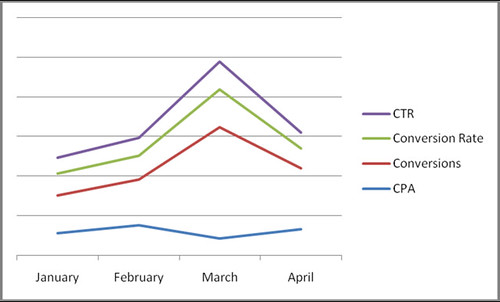Beat the Competition by Anticipating Traffic Changes
The holidays are over. Clicks and conversion rates are dropping back to pre-holiday levels. Instead of mourning the loss of the holidays; it’s time to evaluate the success of last year’s campaigns and set new goals for this year. List your goals and primary metrics First, list your primary and secondary goals. Take stock of […]
The holidays are over. Clicks and conversion rates are dropping back to pre-holiday levels. Instead of mourning the loss of the holidays; it’s time to evaluate the success of last year’s campaigns and set new goals for this year.
List your goals and primary metrics
First, list your primary and secondary goals. Take stock of what you want to accomplish with your PPC marketing. Is it both eCommerce and a newsletter subscription? Maybe it’s page views per visitor first and paid newsletter subscriptions second.
Secondly, list the primary metrics in your PPC account that you need to track to reach those goals.
Lastly, hopefully you can already track those metrics. If not, you need to put some tracking in place immediately.
Chart your account’s trends
It is important to note how our account changes on a seasonal basis. The ability to anticipate changes to your account and change bids or conversion types before those days arrive will give you a competitive advantage.
First, create a chart with your primary metrics and goals. A good place to start is usually:
- Click-through rate(CTR)
- Spend
- Total conversions
- Cost per action (CPA)
- Conversion rates
- Your other main metrics and goals
Segment those metrics by inventory type, such as:
- AdWords Search
- AdWords Content
- AdWords Placements
- Yahoo Search
- Yahoo Content
- Microsoft Live Search
It is important to keep search vs content metrics separate.
And finally, timeframe:
- Day
- Week
- Month
- Year
Even if you don’t think you have a seasonal business, run at least one report for content and another for search on a daily, weekly, and monthly basis. It might take some time, but if you discover a new pattern, you might be able to optimize your account in new ways. Don’t forget to also chart by day of the week. Look to see if there is some seasonality in search patterns. Optimizing bids by days or time of day can dramatically increase your ROI.
Examine the charts
Start your examination with the search charts. When you see major changes from the norm – investigate.
If your investigation leads you to the conclusion that a breaking news story made an impact on your PPC account, you might want to set up a Google alert so you know if a similar story is breaking again so you can make quick changes to your account before the search traffic increases.
If you see a pattern that people are buying more on Monday than Saturday, you might want to consider day parting.
It could be that your goods aren’t directly related to holiday, but are ancillary and it might be worthwhile testing a holiday campaign.
The number of possibilities are endless. However, understanding how your metrics change over time will help you anticipate the change in traffic so you will be prepared when the different type of traffic arrives.
Next steps
Once you’ve determined when you need to make changes, document what the changes are. At this point in time, you’re very familiar with the trends in your account and it’s better for you to list out the changes you will want to make.
If you’ve determined that when a news story runs about a particular subject, your clicks go up and your conversions decrease dramatically, you might want to pause your content campaign or switch to a different ad copy. List out those changes and associate them to a Google alert. Do not just list out that you need to change the ad copy. Write some of the new ads now. You might even want to do a some testing to make sure the new ads will promote your website’s goals.
If you will need to make bulk changes to your account, create a draft campaign in the AdWords editor, adCenter Desktop, or Yahoo’s bulk import.
If you see that on a particular date your conversion rate spikes, you might want to increase your bids and budget for that time frame. Set a reminder in your calendar to make those changes on a set date. Don’t forget the second reminder to put the bids back to normal.
Conclusion
While charting out your account will not allow you to completely divine the future. It will give you a guideline of when it will rain and when the days are most likely to be sunny.
It’s pretty easy to run a report each month, look to see how different keywords are performing and then change bids as necessary. That’s how most campaigns are run. That type of management does not lend itself to maximizing your account’s performance.
If you can anticipate traffic changes, you can swiftly make decisions that will will increase your account’s effectiveness. Don’t wait for the traffic to change, predict the future of your PPC accounts.
Opinions expressed in this article are those of the guest author and not necessarily Search Engine Land. Staff authors are listed here.
Related stories
